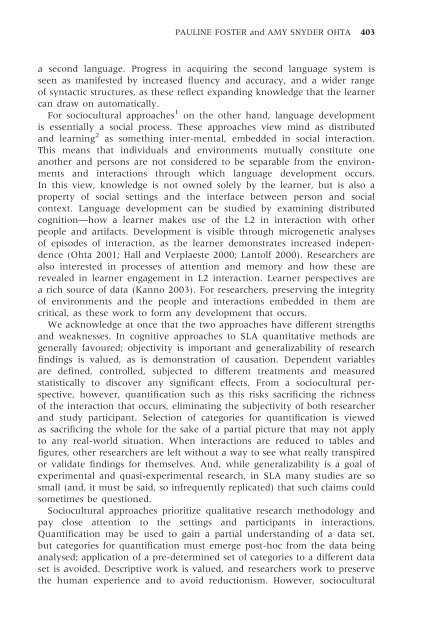Negotiation for Meaning and Peer Assistance in Second Language ...
Negotiation for Meaning and Peer Assistance in Second Language ...
Negotiation for Meaning and Peer Assistance in Second Language ...
You also want an ePaper? Increase the reach of your titles
YUMPU automatically turns print PDFs into web optimized ePapers that Google loves.
PAULINE FOSTER <strong>and</strong> AMY SNYDER OHTA 403<br />
a second language. Progress <strong>in</strong> acquir<strong>in</strong>g the second language system is<br />
seen as manifested by <strong>in</strong>creased fluency <strong>and</strong> accuracy, <strong>and</strong> a wider range<br />
of syntactic structures, as these reflect exp<strong>and</strong><strong>in</strong>g knowledge that the learner<br />
can draw on automatically.<br />
For sociocultural approaches 1 on the other h<strong>and</strong>, language development<br />
is essentially a social process. These approaches view m<strong>in</strong>d as distributed<br />
<strong>and</strong> learn<strong>in</strong>g 2 as someth<strong>in</strong>g <strong>in</strong>ter-mental, embedded <strong>in</strong> social <strong>in</strong>teraction.<br />
This means that <strong>in</strong>dividuals <strong>and</strong> environments mutually constitute one<br />
another <strong>and</strong> persons are not considered to be separable from the environments<br />
<strong>and</strong> <strong>in</strong>teractions through which language development occurs.<br />
In this view, knowledge is not owned solely by the learner, but is also a<br />
property of social sett<strong>in</strong>gs <strong>and</strong> the <strong>in</strong>terface between person <strong>and</strong> social<br />
context. <strong>Language</strong> development can be studied by exam<strong>in</strong><strong>in</strong>g distributed<br />
cognition—how a learner makes use of the L2 <strong>in</strong> <strong>in</strong>teraction with other<br />
people <strong>and</strong> artifacts. Development is visible through microgenetic analyses<br />
of episodes of <strong>in</strong>teraction, as the learner demonstrates <strong>in</strong>creased <strong>in</strong>dependence<br />
(Ohta 2001; Hall <strong>and</strong> Verplaeste 2000; Lantolf 2000). Researchers are<br />
also <strong>in</strong>terested <strong>in</strong> processes of attention <strong>and</strong> memory <strong>and</strong> how these are<br />
revealed <strong>in</strong> learner engagement <strong>in</strong> L2 <strong>in</strong>teraction. Learner perspectives are<br />
a rich source of data (Kanno 2003). For researchers, preserv<strong>in</strong>g the <strong>in</strong>tegrity<br />
of environments <strong>and</strong> the people <strong>and</strong> <strong>in</strong>teractions embedded <strong>in</strong> them are<br />
critical, as these work to <strong>for</strong>m any development that occurs.<br />
We acknowledge at once that the two approaches have different strengths<br />
<strong>and</strong> weaknesses. In cognitive approaches to SLA quantitative methods are<br />
generally favoured; objectivity is important <strong>and</strong> generalizability of research<br />
f<strong>in</strong>d<strong>in</strong>gs is valued, as is demonstration of causation. Dependent variables<br />
are def<strong>in</strong>ed, controlled, subjected to different treatments <strong>and</strong> measured<br />
statistically to discover any significant effects. From a sociocultural perspective,<br />
however, quantification such as this risks sacrific<strong>in</strong>g the richness<br />
of the <strong>in</strong>teraction that occurs, elim<strong>in</strong>at<strong>in</strong>g the subjectivity of both researcher<br />
<strong>and</strong> study participant. Selection of categories <strong>for</strong> quantification is viewed<br />
as sacrific<strong>in</strong>g the whole <strong>for</strong> the sake of a partial picture that may not apply<br />
to any real-world situation. When <strong>in</strong>teractions are reduced to tables <strong>and</strong><br />
figures, other researchers are left without a way to see what really transpired<br />
or validate f<strong>in</strong>d<strong>in</strong>gs <strong>for</strong> themselves. And, while generalizability is a goal of<br />
experimental <strong>and</strong> quasi-experimental research, <strong>in</strong> SLA many studies are so<br />
small (<strong>and</strong>, it must be said, so <strong>in</strong>frequently replicated) that such claims could<br />
sometimes be questioned.<br />
Sociocultural approaches prioritize qualitative research methodology <strong>and</strong><br />
pay close attention to the sett<strong>in</strong>gs <strong>and</strong> participants <strong>in</strong> <strong>in</strong>teractions.<br />
Quantification may be used to ga<strong>in</strong> a partial underst<strong>and</strong><strong>in</strong>g of a data set,<br />
but categories <strong>for</strong> quantification must emerge post-hoc from the data be<strong>in</strong>g<br />
analysed; application of a pre-determ<strong>in</strong>ed set of categories to a different data<br />
set is avoided. Descriptive work is valued, <strong>and</strong> researchers work to preserve<br />
the human experience <strong>and</strong> to avoid reductionism. However, sociocultural














